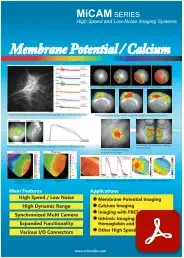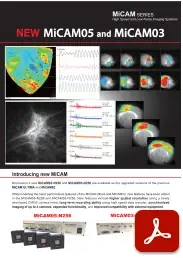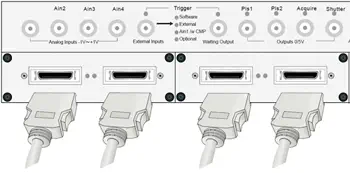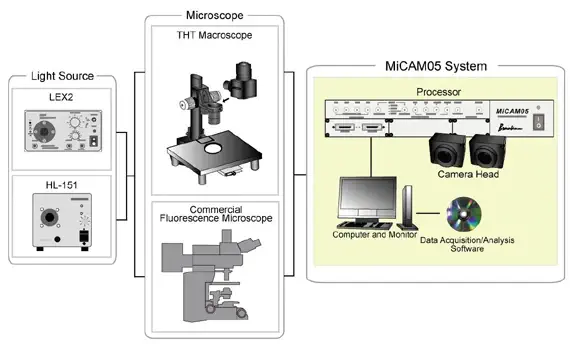MiCAM05-N256 is a high-speed camera system that captures and visualizes small changes in fluorescence intensity from biological samples stained with fluorescent probes, such as voltage sensitive dye and calcium dye.

- Multifunction High Speed Camera System
-
MiCAM05-N256
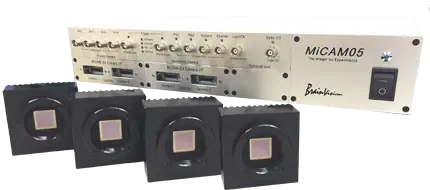
Main Features
- Spatial Resolution
- 256 x 256 - 32 x 32 pixels
- Image Sensor Size
- 17.6mm x 17.6mm
- S/N Ratio
- > 71dB
- Camera Port
- 4
- Memory
- 4GB
- Maximum Frame Rate
- 1,923fps (256 x 256px)
5,556fps (128 x 128px)
20,000fps (32 x 32px)
Applications
- Membrane potential (voltage sensitive dye) imaging
- Calcium imaging for in vivo brain/cardiomyocytes
- Imaging with FRET, GCaMP, GEVI
- Intrinsic optical signal imaging based on hemoglobin and flavoprotein autofluorescence
- Ratiometric fluorescence imaging with 2 camera heads
- Panoramic imaging with 2-4 camera heads
- Other high speed imaging
Sample Data
Voltage Sensitive Dye Imaging using MiCAM05-N256
- Sample
- Brain Slice
- Method
- Electrical stimulation
- Fluorescence Dye
- Voltage sensitive dye (Di-4-Anepps)
- Imaging System
- MiCAM05-N256
- Pixels
- 256x256
- Frame Rate
- 1,000fps (1.0msec/frame)
- Provided by
- Dr.Takashi Tominaga, Institute of Neuroscience, Tokushima Bunri University
High-Speed Calcium Imaging of Isolated Mouse Atrial Cardiomyocytes
- Sample
- Freshly isolated mouse atrial cardiomyocytes. Cells were plated on glass cover slips coated with laminin and used on the same day as isolation.
- Method
- Cells were paced by electrical field applied through a perfusion solution. Imaging was performed on Nikon DIAPHOT 300 microscope with 20X lens and SPECTRA-X Lumencor light source.
- Fluorescence Dye
- Calcium sensitive dye (Fluo-4 AM)
- Imaging System
- MiCAM05-ULTIMA
- Pixels
- 100x100
- Frame Rate
- 200fps (5.0msec/frame)
- Provided by
- Dr. Roman Medvedev and Dr. Alexey Glukhov, Department of Medicine, University of Wisconsin-Madison
Brochure Download
-
High Speed Imaging System MiCAM Series (2019)
MiCAM05-N256 and MiCAM03-N256
Features : Camera Head
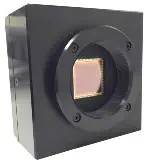
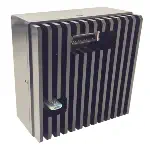
N256 camera head is equipped with a new CMOS image sensor designed and developed by Brainvision Inc.
Large Sensor and Large Pixel
- Active Area size
- 17.6mm x 17.6mm
- Pixel size
- 69μm x 69μm
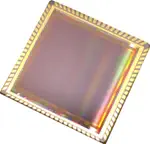 Applications such as membrane potential imaging require both very high speed, and the ability to
detect small changes in
fluorescence, such as 0.5-1%. In order to optimize S/N ratios, it is important to increase the
amount of light captured by
one pixel. It is easy to collect light and capture small changes using a sensor having large
pixels.
Applications such as membrane potential imaging require both very high speed, and the ability to
detect small changes in
fluorescence, such as 0.5-1%. In order to optimize S/N ratios, it is important to increase the
amount of light captured by
one pixel. It is easy to collect light and capture small changes using a sensor having large
pixels.
High Spatial Resolution, High Frame Rates, and High S/N Ratios
- Number of Pixels
- 256 x 256 pixels
- Maximum Frame Rate
- 1,818 fps (at 256x256 pixels)
- Dynamic Range
- 71dB
The overall performance has been improved in a balanced manner. This includes maximum frame rate, spatial resolution, and S/N ratios, all of which are important factors for high-speed membrane potential imaging.
Wide Dynamic Range Mode or High Sensitivity Mode by Adjustable Well Depth
- Wide Dynamic Range Mode
- 3,000,000 electrons
- High Sensitivity Mode
- 600,000 electrons
It is now possible to easily switch the full well capacity of the camera in the acquisition software. Two modes are available: wide dynamic range mode (D-mode), and high sensitivity mode (S-mode). D-mode is used for tissue samples with high fluorescence light intensity, and S-mode is used for cultured cell monolayers, or preps with low fluorescence light intensity. This adjustable well depth makes it possible to image a variety of biological samples using a single camera.
ROI Readout for Higher Frame Rates
Preset partial readout setting and multiple ROI setting can be selected, and as a result it is possible to achieve higher frame rates. For example, ultra high frame rates such 20,000 fps@32x32 pixels is possible.
-
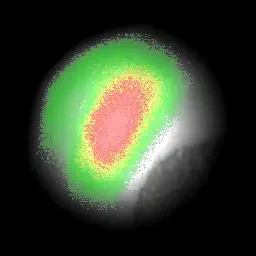 All pixels readout (256x256 pixels)
All pixels readout (256x256 pixels)
-
 Multiple ROI readout (32x32x9 pixels)
Multiple ROI readout (32x32x9 pixels)
Features : Processor

Direct Data Saving and Long-Term Data Acquisition with USB3.0 High-Speed Data Transfer
New USB3.0 interface allows for significantly faster data transfer from processor to PC. It is now possible to save data directly to HDD or SSD, and long-term recording of several minutes up to a few hours can be achieved, regardless of the RAM capacity (Note that sampling rate, number of pixels, number of cameras used, and PC specifications, will affect the total recording time).
Approximate number of recordable frames and recordable timeDisk Capacity Pixels Frame Rate (fps) Number of recordable frames Recordable time (min) SSD 1TB 256x256 500 6,840,000 228.0 1,000 6,840,000 114.0 1,818 6,840,000 62.7 128x128 500 27,360,000 912.0 1,000 27,360,000 456.0 5,263 27,360,000 86.6 (*Approximate number of recordable frames and recordable time shown above are averaged values that were measured using the PC configuration which is included with MiCAM05. There is no guarantee that the results will be the same in all circumstances.)
Up to four cameras can easily be connected and used in a completely synchronized multi-camera system
Up to two camera interface boards can be connected to the MiCAM05 processor. Each interface board is equipped with two camera ports, therefore up to four of the same type of camera head can be connected at any time. This allows for simultaneous imaging of multiple fluorescent wavelengths, as well as three-dimensional imaging from different angles.
Continuous output of light intensity is available as a standard function
The light intensity monitor/continuous output function, available as an optional component of MiCAM Ultima (DAC/ADC expanding unit), is available as standard equipment with MiCAM05. This function is designed to output the light intensity changes of up to eight user selected pixels via eight BNC connections. Therefore, waveforms of fluorescence change can be monitored and output before, during, and after data acquisition. It is also possible to monitor the change in light intensity in real time, using optional software.
-
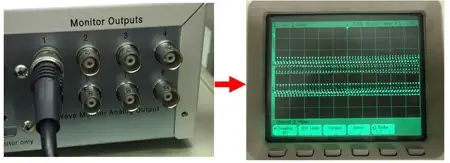 Light intensity outputs from eight BNC connections
Light intensity outputs from eight BNC connections
-
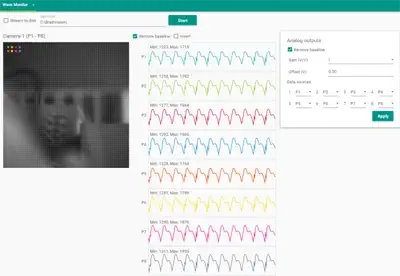 Wave monitor on software
Wave monitor on software
Synchronous Lighting Control of LED Light Source for Multi-Wavelength Excitation Imaging (Optional)
In the case of imaging using multiple fluorescent probes with different excitation wavelengths or imaging using a two-wavelength excitation/single-wavelength fluorescent probe, it is necessary to synchronize the frame timing of the camera and the lighting timing of the light source.
This function is to output the lighting signal synchronized with each frame timing from MiCAM05 to multiple LED light sources. This makes it possible to easily synchronize the frame acquisition with MiCAM05 and LED lighting.
There are up to 4 channels of output. Preset patterns, in which signals are output alternately from each channel, are available. There is no need to set the lighting pattern using a commercially available pulse generator.
Moreover, since the pulse delay time and pulse width can be specified by software, it is possible to make detailed settings in accordance with the rise and fall times of the LED used.-
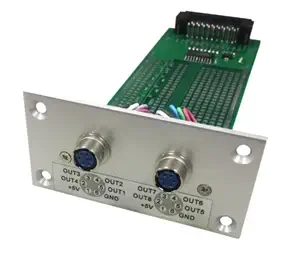 Optional Unit
Optional Unit
-
 Two-wavelength excitation mode
Two-wavelength excitation mode
 Four-wavelength excitation mode
Four-wavelength excitation mode
Various I/O Connectors, and Improved Compatibility with External Devices
MiCAM05 has multiple input and output connections available, in comparison to previous MiCAM systems. These universally standard I/O connections can be synchronized with image acquisition and external devices. An additional slot has been added to MiCAM05 so that customization is also available, depending on the research application.
Automatic Light Control and Adjustment of Light Intensity
In addition to the “Shutter” output terminal for controlling the timing of illumination in synchronization with image acquisition, there is a “LightCtl” signal output terminal for automatically adjusting the intensity of the excitation light. In this way, light intensity or saturation percentage of the image captured by the camera, can be adjusted using the software. As the background light intensity becomes similar throughout an experiment and even for different biological preps, the experimental repeatability can be improved.
Other Features
Turnkey System Ready for Immediate Use
The system consists of hardware/software specifically designed for high-speed fluorescence imaging, and the PC and monitor are included as standard equipment. Before use, calibration/setting/tuning is not necessary. The hardware connection is straightforward between components using cables, making it possible to acquire data immediately after setup.
Pre-Post Trigger Mode
MiCAM05 can record activity which occurs before and after a trigger signal is generated. When an external trigger occurs, such as a spontaneous biological signal, or a trigger pulse from an external stimulator, a specified amount of "pre-trigger" data can be saved. The "post-trigger" data is also collected in the same recording. As a result, both pre-trigger data and post-trigger data can be saved within one acquisition period.
-
 Pre-Post Trigger Mode (75% Pre-Trigger)
Pre-Post Trigger Mode (75% Pre-Trigger)
Time Lapse Imaging
MiCAM05 can capture phenomenon that changes in a few minutes up to several hours, intermittently. Because illumination light is turned on only at the time of image acquisition, phototoxic effects to sample is minimized, and a stable baseline can be acquired.
-
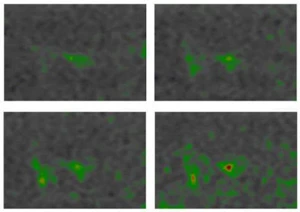 Example of Time-lapse imaging
Example of Time-lapse imaging
High Resolution Camera Control Function (Optional)
It is possible to control a high resolution camera having 1920x1200 pixels (BV-XB1 camera). High resolution imaging can be applied to various applications, including detection of intracellular Ca 2+ dynamics, flavoprotein fluorescence, FRET imaging, and also imaging of animal behaviors. High resolution imaging with BV-XB1 can also be synchronized with MiCAM05 high-speed imaging.
-
 BV-XB1
BV-XB1
-
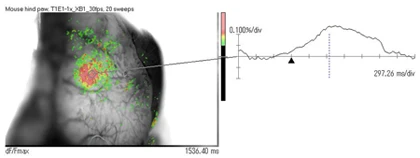 Example of flavoprotein imaging
Example of flavoprotein imaging
Software
Acquisition/Analysis Software (BV Workbench)
BV Workbench is the image acquisition software that controls MiCAM05-N256 imaging system. In addition to image acquisition and control of inputs and outputs of the imaging system, analysis functions including movie playback, wave display, filter functions, etc…are also included. BV Workbench has an intuitive user interface that is easily operated with the use of a mouse.
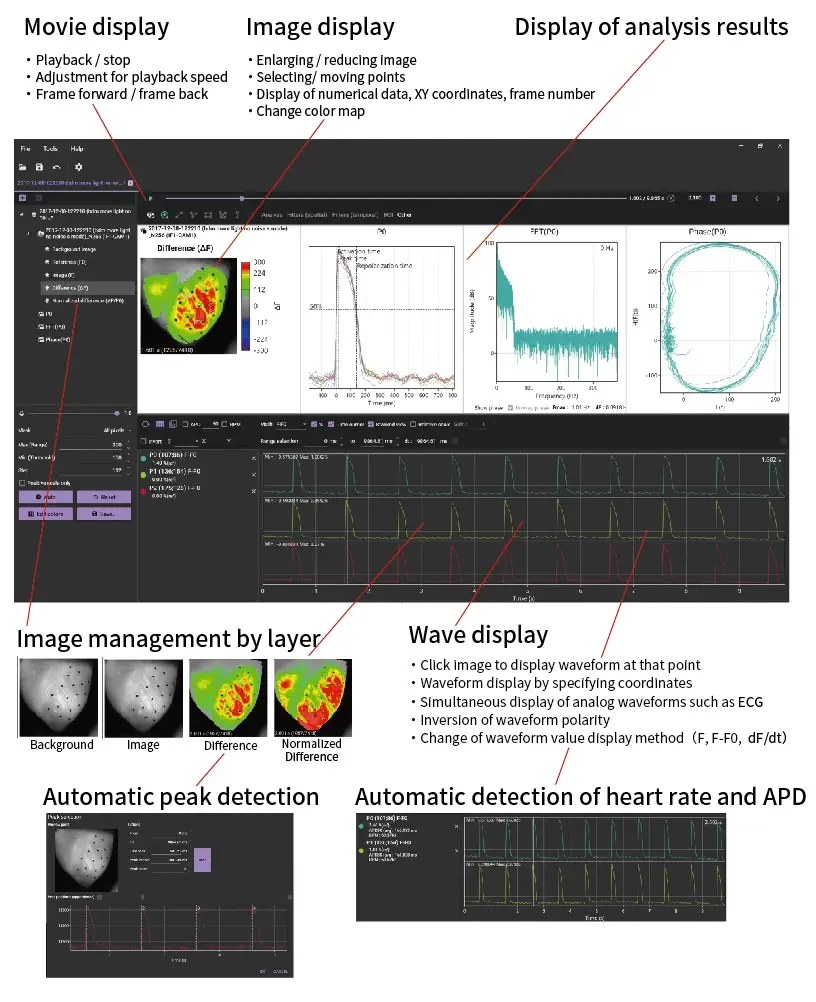
Specifications
* Specifications and appearance are subject to change without prior notice due to continuous improvements.System Name High Speed Imaging System
MiCAM05-N256High Speed Imaging System
MiCAM05-HRModel MC05-N256 MC05-HR Standard System Configuration Camera Head (1-4), Processor, PC, Monitor,
Acquisition software, Analysis SoftwareSupported OS Windows 7/10 64bit Camera Head Name N256 camera HR camera Model MC-N256CAM 02HRCM Image Sensor Original CMOS Sony CCD Active Pixels (H x V) 256 x 256 380 x 244 Active Image Area (H x V) 17.6mm x 17.6mm 6.4mm x 4.8mm Pixels Size (H x V) 69μm x 69μm 16.8μm x 19.6μm Shutter Mode Global Global Maximum Frame Rate and
Pixels (for 1 camera)1,923fps (256x256px)
3,125fps (192x192px)
5,556fps (128x128px)
20,000fps (32x32px)143fps (380x244px)
270fps (188x120px)
455fps (92x60px)Quantum Efficiency 55%@550nm / 50%@600nm 75%@550nm / 50%@700nm Well-Depth 3,000,000 e- / 600,000 e- (switching) 100,000e- (180x120px) /
12,000e- (180x120px, H-bin)Dark Noise 500 e- / 130 e- 60e- (3.7ms,180x120px) /
20e- (3.7ms,180x120px,H-bin)Lens mount Original M42 mount
(flange back:14.5mm)
(Option: C or F mount)C mount Interface Special Cable Special Cable Dimension (WxHxD) 80mm x 80mm x 50mm 62mm x 52mm x 46mm Weight 474g 100g Processor Name MiCAM05 processor Model MC05-PRC Camera Interface 1 (up to 2) Camera Port 2 (up to 4) Slot for Optional Unit 1 Buffer Memory Inside Processor 4GB (up to 8GB) Analog Inputs for
Synchronous Recording4ch Output for Stimulation Pulse 2ch Input for External Trigger Signal 1ch Output for Lighting Control 1ch Input/Output for Frame Timing 1ch Output for Real Time
Light Intensity Monitor8ch Output for Light Intensity Control 2ch Current Output 2ch Output for Acquisition Status 1ch Output for Trigger Wait Status 1ch Digital I/O port 1 (25 pins) Trigger Mode Software / TTL External Input / Analog Input / Usage of Optional Unit Data Transfer Mode USB3.0 (for basic functions) / USB2.0 (for Real Time Light Intensity Monitor) Recording Mode Temporary storage to PC RAM / Direct data saving to PC drive (SSD/HDD) Maximum Recordable Frame Number Dependent on camera used and image acquisition settings Power Supply AC100V-230V、50Hz/60Hz 150W Fuse T2A L 250V Dimension 430mm (W) x 350mm (D) x 75mm (H) Weight 6.2kg Default/Optional Function Single Trial Acquisition Default Long Time Acquisition
(direct saving to disk)Default Averaging Acquisition Default Multiple ROI Readout for
Higher Frame RateDefault Time-Lapse Acquisition Default High Resolution Camera Control Option (sold separately) Acquisition software Default Analysis software Default SDK (for Visual C# .NET and MatLab) Option (sold separately)
* This product is for research use only. * This product is made in Japan.Selectable Number of Pixels and Maximum Frame Rate (N256 Single Camera)Selectable Number of Pixels (HxV) Maximum Frame Rate (fps) NR Mode OFF NR Mode ON
2 Times AveragingNR Mode ON
4 Times Averaging256x256 Full Resolution 1,818 1,923 1,031 192x192 Square ROI 2,941 3,125 1,695 128x128 5,263 5,556 3,333 64x64 12,500 12,500 8,333 256x128 Horizontally Long
Rectangle ROI3,333 3,448 1,887 256x64 5,882 5,555 3,226 256x32 9,091 8,333 5,000 128x256 Vertically Long
Rectangle ROI3,030 3,333 1,852 64x256 4,348 5,000 3,125 32x256 5,556 7,143 4,762 32x32 16 blocks 2,381 2,632 1,724 15 blocks 2,500 2,778 1,818 14 blocks 2,703 2,941 1,961 13 blocks 2,857 3,125 2,083 12 blocks 3,125 3,448 2,273 11 blocks 3,333 3,704 2,439 10 blocks 3,704 4,000 2,703 9 blocks 4,000 4,348 2,941 8 blocks 4,545 5,000 3,226 7 blocks 5,000 5,556 3,704 6 blocks 5,556 6,250 4,167 5 blocks 6,667 7,143 5,000 4 blocks 7,692 8,333 5,882 3 blocks 10,000 11,111 7,692 2 blocks 12,500 14,286 10,000 1 blocks 20,000 20,000 16,667 Selectable Number of Pixels and Maximum Frame Rate (N256 Dual Camera)Selectable Number of Pixels (HxV) Maximum Frame Rate (fps) NR Mode OFF NR Mode ON
2 Times AveragingNR Mode ON
4 Times Averaging256x256 Full Resolution 1,087 1,064 1,031 192x192 Square ROI 1,818 1,754 1,695 128x128 3,704 3,571 3,333 64x64 9,091 8,333 8,333 256x128 Horizontally Long
Rectangle ROI2,041 1,961 1,887 256x64 3,571 3,226 3,125 256x32 5,882 5,000 5,000 128x256 Vertically Long
Rectangle ROI2,000 1,961 1,852 64x256 3,571 3,448 3,125 32x256 5,556 5,556 4,762 32x32 16 blocks 1,887 1,613 1,613 15 blocks 2,041 1,724 1,724 14 blocks 2,174 1,852 1,852 13 blocks 2,326 1,961 1,961 12 blocks 2,500 2,128 2,128 11 blocks 2,703 2,326 2,326 10 blocks 2,941 2,500 2,500 9 blocks 3,226 2,778 2,778 8 blocks 3,571 3,125 3,125 7 blocks 4,000 3,448 3,448 6 blocks 4,762 4,000 4,000 5 blocks 5,556 4,762 4,762 4 blocks 6,667 5,556 5,556 3 blocks 8,333 7,143 7,143 2 blocks 11,111 10,000 10,000 1 blocks 16,667 16,667 16,667 Discontinued ModelsSystem Name MiCAM05-Ultima MiCAM05-D225 Model MC05-UL MC05-D225 System Name Ultima camera D225 camera Model CAM-ULT D225 Image Sensor Original CMOS Original CMOS Active Pixels (HxV) 100x100 (fixed) 240x256 (fixed) Active Image Area (HxV) 10.0mmx10.0mm 7.2mmx7.7mm Pixel Size (HxV) 100μmx100μm 30μmx30μm Shutter Mode Rolling Shutter Global Shutter Maximum Frame Rate (for 1 camera) 10,000fps 1,000fps Well-Depth 1,500,000 e- 500,000 e- Lens Mount C mount C mount Dimension (WxHxD) 80mmx65mmx50mm 75mmx65mmx50mm Weight/th> 270g 246g Processor (Same as MiCAM05-N256)
